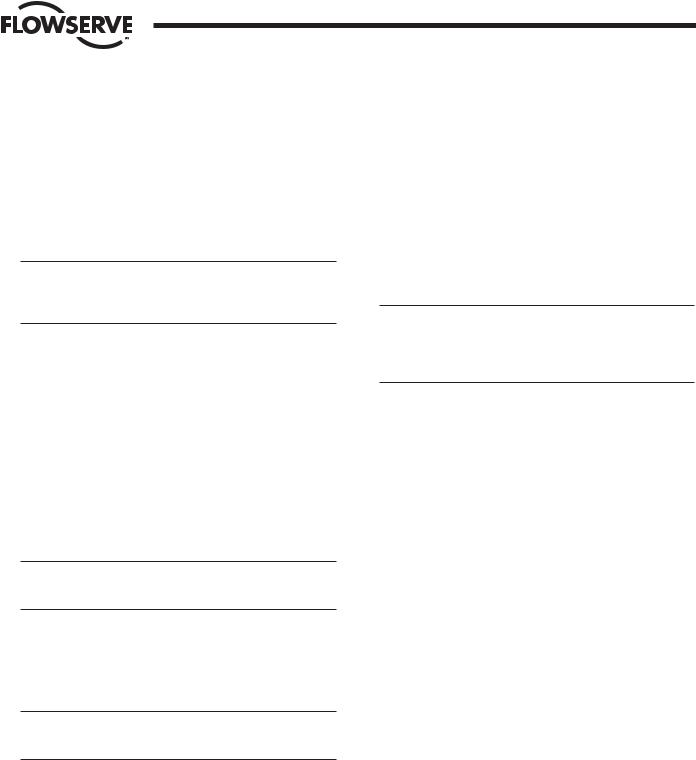Flowserve H71 User Manual

Worcester Control Valves |
14932-D |
High Pressure Series H71
(C0214, C0222, C0224) Ball Valves
Installation, Operation and Maintenance Instructions
CAUTION: Flowserve recommends that all product that must be stored prior to installation be stored indoors, in an environment suitable for human occupancy. Do not store product in areas where exposure to relative humidity above 85%, acid or alkali fumes, radiation above normal background, ultraviolet light, or temperatures above 120°F or below 40°F may occur. Do not store within 50 feet of any source of ozone.
Worcester’s H71 valves will operate to 6000 psi at normal ambient temperature (-40° to 185°F, -20° for carbon steel). If used on liquid medias at these pressures, caution must be practiced. Most liquid medias will flash or cavitate severely when the pressure drop exceeds approximately 40% of the system pressure. Severe valve and valve seat damage can result.
Free discharge at these pressures is not recommended.
INSTALLATION
1.H71 valves may be installed for flow in either direction. Use care to exclude pipe sealants from the valve cavity. Valves with upstream relief hole in ball (V3 option) are one-way valves.
2.Weld End Valves:
NOTE: Prior to welding, THOROUGHLY CLEAN ALL JOINT SURFACES to prevent contamination.
For all weld valves (SW, BW, End Connections):
a.Tack weld valve in place.
b.With valve open, remove all but one body bolt, loosen it and swing out body. Close valve, remove ball, seats and body seals. Return body to its original position and temporarily secure it with two body bolts diagonally opposite each other.
c.Weld valve in line (when gas welding or brazing, do not play flame on valve body).
d.Allow valve to cool, lubricate ball and seat with Lubriplate 930AA and reassemble valve.
e.Tighten and torque body bolts evenly and diagonally opposite each other, alternating in a criss-cross pattern. Use torque figures shown.
CARBON STEEL |
|
STAINLESS STEEL |
|||
BOLTS - B7 |
|
BOLTS - B8 CL2/2B |
|||
|
|
|
|
|
|
Bolt Dia. |
In.-Lbs. |
Ft.-Lbs. |
Bolt Dia. |
In.-Lbs. |
Ft.-Lbs. |
|
|
|
|
|
|
3/8" |
480-540 |
40-45 |
3/8" |
420-480 |
35-40 |
|
|
|
|
|
|
7/16" |
680-720 |
55-60 |
7/16" |
600-680 |
50-55 |
|
|
|
|
|
|
1/2" |
984-1044 |
82-87 |
1/2" |
960-984 |
80-82 |
|
|
|
|
|
|
5/8" |
2100-2136 |
175-178 |
5/8" |
1980-2040 |
165-170 |
|
|
|
|
|
|
3/4" |
2940-3000 |
245-250 |
3/4" |
2520-2580 |
210-215 |
|
|
|
|
|
|
NOTE: Stainless steel bolts and nuts are generally used in all threepiece valves with stainless steel bodies.
f.Cycle the valve three times to break in the seats.
OPERATION
1.The operation consists of turning the handle and/or stem a quarter-turn clockwise to close and a quarter-turn counterclockwise to open. When the handle and/or stem flats are in line with the pipeline, the valve is open.
2.These valves will provide bubble-tight shut-off when used in accordance with Worcester’s published pressure/temperature chart.
3.It is not good practice to leave a ball valve partly open (throttling operation) without knowledge of the pressure drop and flow at that position.
4.As shipped from the factory, all valves may contain a siliconebased lubricant (H71 valves also contain a lithium based grease). This is for break-in purposes, and may be removed if it is objectionable for a particular application by disassembling and solvent washing. Lacquer thinner will remove the lubricant.
5.Media which can solidify, crystallize or polymerize should not be allowed to stand in ball valve cavities.

Flow Control Division
Worcester Control Valves
6.Torque Requirements - Operating torque requirements will vary depending on the length of time between cycles, line pressure, type of valve seats, and the media in the system. For a detailed analysis of valve torque requirements, see the Worcester Actuator Sizing Manual.
MAINTENANCE
Tighten retaining nut if seepage is noted at stem.
CAUTION: For maximum stem seal life, proper stem adjustment procedure must be followed. Excessive tightening causes higher torque and shorter stem seal life.
For 1/2"–1 1/2" Valves with two Stem Nuts and a Lockwasher (Manual Valves):
1.Tighten retaining nut (lower nut) until Belleville washers are flat, the nut will “bottom”.
2.Back off retaining nut 1/6 turn.
3.Tighten top nut securely to lock retaining nut in place.
For 1/2"–1 1/2" Valves with Self-Locking Stem Nut and four Belleville washers (Automated Valves):
1.Tighten self-locking stem nut until Belleville washers are flat, the nut will “bottom”.
2.Back off 1/3 turn.
CAUTION: The self-locking stem nut is difficult to tighten, and must fully flatten Belleville washers before backing off.
For 2" Valves
1. Tighten retaining nut 1/6 turn at a time until seepage stops.
REBUILDING
a WARNING: Ball valves can trap high-pressure fluids in ball cavity when closed.
If the valve has been used to control hazardous media, it must be decontaminated before disassembly. It is recommended that the following steps be taken for safe removal and disassembly:
•Relieve the line pressure. Operate the valve prior to attempting removal from line.
•Place valve in half-open position and flush the line to remove any hazardous material from valve. (See Caution, page 1,
paragraph 2.)
•All persons involved in the removal and disassembly of the valve should wear the proper protective clothing such as face shield, gloves, apron, etc.
2
1.A standard repair kit may be ordered for these valves, consisting of seats and body seals, two or four Belleville washers, stem seals, and thrust bearings. Specify the material of seats and body seals, size, Series and R number (revision number) of valve or for non-standard valve, the “P”, “T”, “C”, or similar number, as found on the valve nameplate or on the actuator bracket nameplate. If valve body is stainless steel, place a “6” after valve size in repair kit ordering code.
To Order:
Valve Size/HRK71/Material/Rev. Number or P, T, C, etc. Number
Example: 1" 6 HRK71 XV C0222
CAUTION: If the seats and seals installed differ from those removed, the valve nameplate or stop must be replaced or remarked to indicate the altered materials and ratings, or valve tagged to so indicate.
2.To replace seats and seals:
a.Place valve in open position, remove all but one of the body nuts and bolts, loosen remaining one, swing out center section from between pipe ends with valve open.
b.With valve in closed position, remove old seats, body seals, and ball.
c.For 1/2"–1" valves remove handle nut, lockwasher, one-piece handle and stop (if manual valve). (This step is not applicable to valves with self-locking stem nut.)
For 1-1/2" valves only, remove handle nut, lockwasher, onepiece wrench/stop and extension (if manual valve). This step is not applicable to valves with self-locking stem nut.
For 2" manual valves only, remove handle assembly (wrench block and extension), by removing hex head screw.
d.Using handle or a wrench to prevent stem from turning, remove retaining or self-locking stem nut, stop (2" manual valve only, or stem spacer if automated valve), Belleville washers (1/2"–1 1/2" only), and follower from stem. Remove stem through body cavity.
e.Remove thrust bearing(s) from body or stem, stem seals, and stem seal protector from recess in top of body.
f.Clean all sealing surfaces of valve including the ball.
NOTE: The ball and the surfaces against which the seats and seals are installed should be undamaged, clean and free of pit marks and scratches. Light marring from the action of the ball against the seats is normal and will not affect the operation of the valve. Flaws which can be seen but barely detected with fingertips are acceptable. The stem and body surfaces that the thrust bearings and stem seals contact must be undamaged, clean, and free from pit marks and scratches.
g.Lightly lubricate the ball, seats, body seals, stem seals, stem seal protector, and thrust bearings with a lubricant compatible
14932-D
